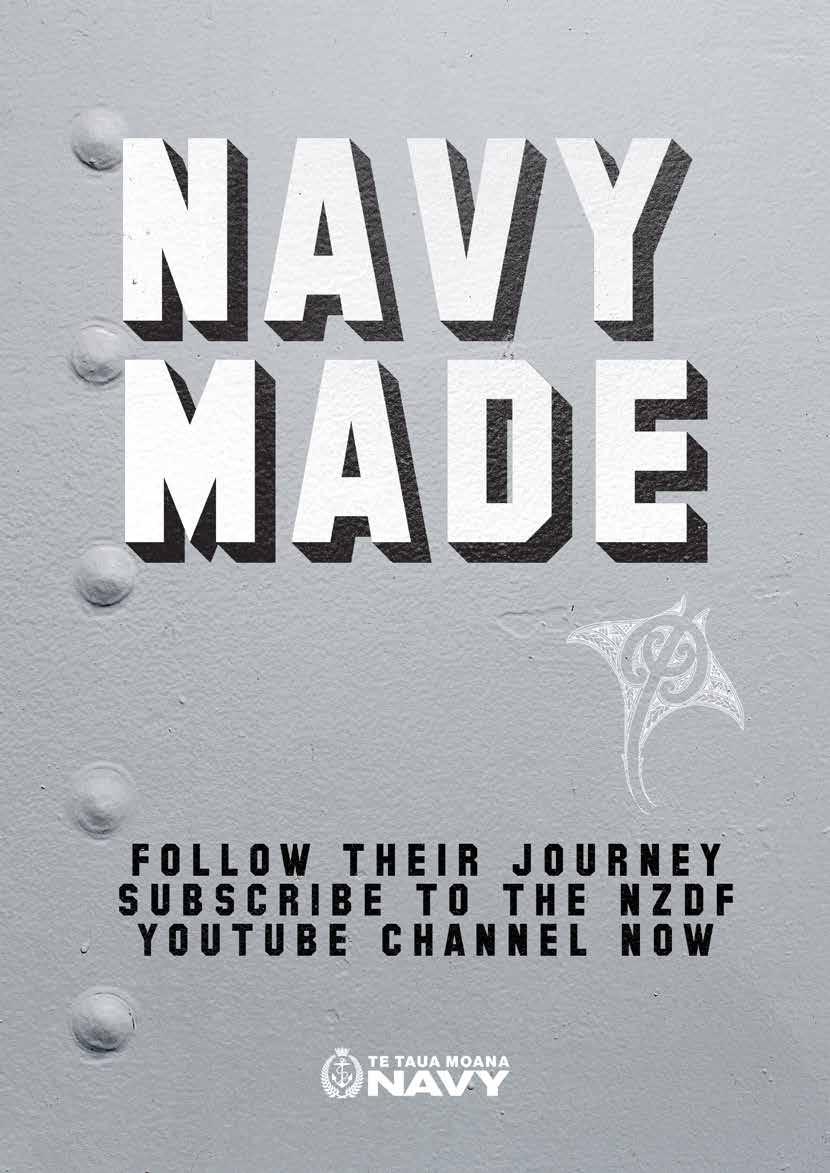
# 2 7 0 O C T 2 2 FAREWELL TO QUEEN ELIZABETH II OPERATION RENDER SAFE HMNZS AOTEAROA NAVIGATION TRAINING REMNANTS MAPPING WAR
Today is the official magazine of the Royal New Zealand Navy.

to inform, inspire and entertain serving and former members of the RNZN, their families, friends and the wider Navy Community.
by: Defence Public Affairs
NZ Defence Force Wellington, New Zealand
Andrew Bonallack
navytoday@nzdf.mil.nz
Design and Layout: Defence Public Affairs
by: Bluestar
Bag 39996, Wellington
navytoday@nzdf.mil.nz
“And then the two-minute silence, and London went quiet. You could have heard a pin drop. Everyone was captured in that moment.”
CDR Andy Mahoney, following the funeral procession for Her Late Majesty Queen Elizabeth II.
are welcomed, including stories, photographs and letters. Please submit stories and letters by email in Microsoft Word or the body of an email. Articles up to 500 words welcomed, longer if required by the subject. Please consult the editor about long articles. Digital photos submitted by email also welcomed, at least 500kb preferred. Stories published in Navy Today cannot be published elsewhere without permission.
deadline is the 15th of the month for the following issue. Subject to change.
expressed in Navy Today are not necessarily those of the RNZN or the NZDF.

Careers:
0800 1FORCE (0800 136 723) www.defencecareers.mil.nz

Changing Address?
join or leave our mailing list, please contact:
navytoday@nzdf.mil.nz
Eduard Korent surfaces during an Operation Render Safe dive in Tuvalu.
Chris Weissenborn
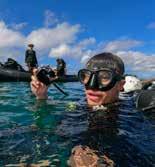
Contents 04 Operation Render Safe 10 Navigation training with HMNZS AOTEAROA 12 Farewell to Queen Elizabeth II 16 Teaching law at West Point 24 Navy Band activities 26 GP trains as Navy Reservist 30 Korean War veteran 33 Junior Officer competition 35 15 rounds Navy
Established
Published
HQ
Editor:
Email:
Printed
Private
Distribution: Email:
Contributions
Copy
Views
Defence
Phone:
To
Email:
–
Front Cover: ADR
Photographer: PO
2612 NZDefenceForce NZNavy navy.mil.nz 30 2 | Navy Today #270
Yours Aye
Chief of Navy

Ma te Atua e manaaki te Kuini –God bless the Queen
September 2022 was most definitely a month for the history books. As a Navy, we joined the nation and the Commonwealth in acknowledging with great sadness the passing of Her Majesty Elizabeth the Second, Queen of New Zealand.
We have been proud to serve and swear (or affirm) our allegiance to Her Majesty the Queen as our Monarch and Head of the Armed Forces of New Zealand, and thereby Te Taua Moana o Aotearoa/The Royal New Zealand Navy, for over 70 years. Her reign was long, her influence hugely positive and often stabilising in a somewhat uncertain world. Her example of ‘service’ above self is something I will continue to reflect on.
Aue te aroha
Aue te pouri
E te Arikinui, te Kuini moe rangimarie mai i roto i nga ringaringa o to tatou kaihanga
E te Arikinui haere atu ra
Alas, sympathy and affection Alas, the sadness
To the Most High Chieftainess, our Queen rest now peacefully in the hands of the Creator Farewell great one
Acknowledging the parades, memorials and official mourning period have concluded, I nonetheless observe her passing and the accession of King Charles III will continue to reverberate for a while. Our ships are now His Majesty’s New Zealand Ships, the Oath or Affirmation that sailors make on attestation is now to our King, there is no longer a requirement to fire a gun salute on 6 February (we were not saluting Waitangi Day as many thought; the salute was in honour of the accession of Queen Elizabeth II on that day in 1952). As we work through the more administrative aspects of this special period in time, what does not change is our allegiance to serving Aotearoa New Zealand and our fellow citizens. Ma te Atua e whakaora te Kingi –God save the King
As you read through the rest of this Navy Today you will see stories from sailors outlining other things occurring in the Navy and NZDF. From working alongside our partners in OP RENDER SAFE in the Pacific, through shipmates on exchange and training overseas and at sea, through HMNZS TAUPO providing support to the clean-up in the Tasman district, and the high level results of the Maritime Culture survey, we are busy delivering goodness as we go about regenerating ourselves. As we continue this mahi, I encourage you to reread last month’s Yours Aye editorial by Commodore Golding. He simply outlines the need for change and succinctly discusses the regeneration kaupapa.
One critical challenge we are currently facing is attrition. As I type this article I have just been advised RNZN attrition continues to rise and we have just passed 15 per cent on a rolling 12-month average. While there are a number of things we are doing as a Defence Force and Navy, I hear the message from sailors that base remuneration is now the most critical matter to address. I assure you that I, alongside the NZDF Executive, are in support of CDF as he goes about working with our Minister and government to respond to the issue.
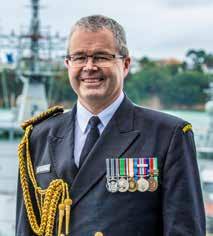
His interview in the 18 September Newshub article makes it clear that
further support is needed to respond to the market competition for you, our highly trained workforce. I am confident we can and will address the base remuneration issue, and I am aware of other conditions of service changes that are imminent.
I certainly do not lose sight of the fact that sailors going to sea in ships, and the opportunity to get ashore overseas, is also critical to us enjoying our ‘service’ and committing to remain in the Navy. The recent ‘better work stories’ from HMNZS AOTEAROA, WELLINGTON, MANAWANUI and MATATAUA remind me of the value and satisfaction that comes from being at sea. However, I am critically aware that changes to remuneration and conditions of service, along with effort to address other career dissatisfiers, is the primary mahi for me at the moment.
Looking ahead, I am keen to see the operational release of HMNZS MANAWANUI and AOTEAROA in the next few months. Similarly, HMNZS TE MANA will progress the introduction into service of her new combat capabilities. These are important regeneration steps for our navy, and as we progress them I offer my thanks to all of you who have been involved. From project staff to Ship’s Company, I know the work has been long and hard. However, the benefit to New Zealand is now being delivered, and the capability they represent is military effect we should all be proud of.
As I close, I ask us all to keep an eye on each other. It has been a winter of many ailments and I am aware of many workplace pressures that impact on our mental health. Keep an eye out, offer a hand, and remind each other of the various avenues available for health and welfare assistance. Asking for help is hard… it is much easier when your mate helps.
He heramana ahau.
Rear Admiral David Proctor Chief of Navy
Navy Today #270 | 3
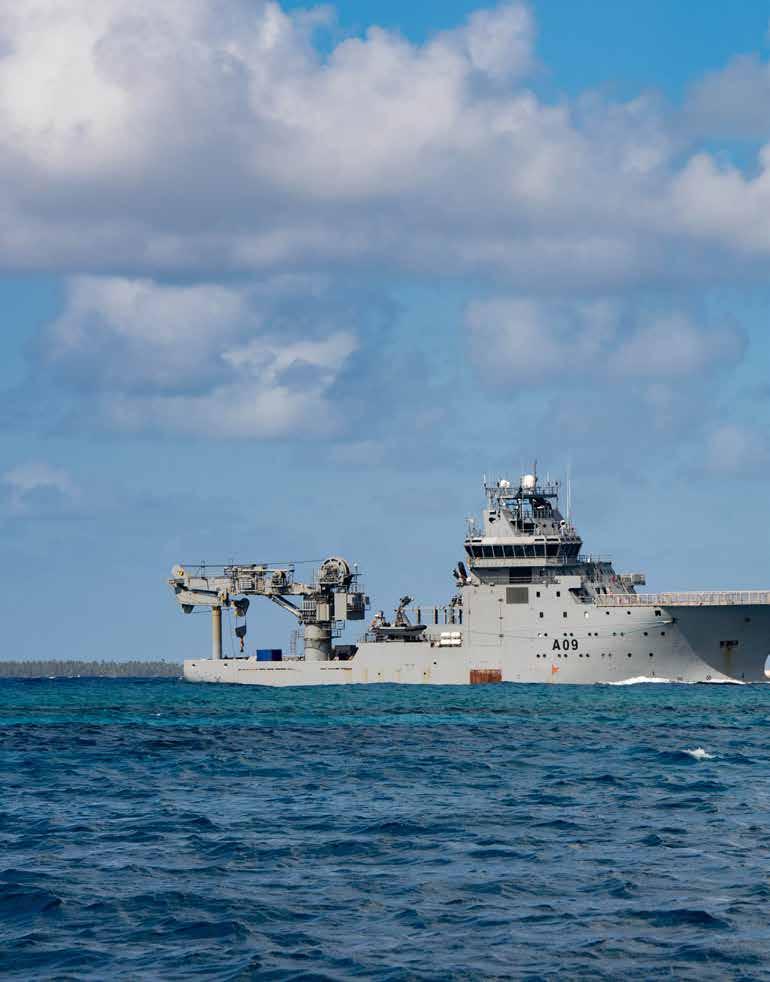
4 | Navy Today #270
INTERNATIONAL DIVE FORCE MAPS WAR REMNANTS
World War II isn’t over for some small Pacific territories, whose jungles and waters contain high explosives and ammunition. Last month, HMNZS MANAWANUI hosted dive teams from multiple nations to locate explosive remnants of war in Tuvalu.

OPERATION RENDER SAFE
Navy Today #270 | 5
Photography: PO Chris Weissenborn
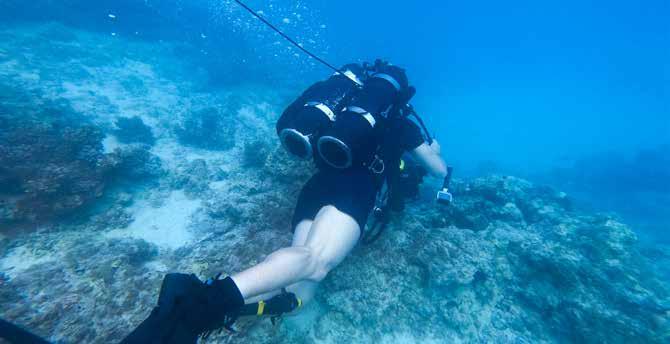
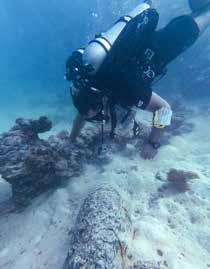

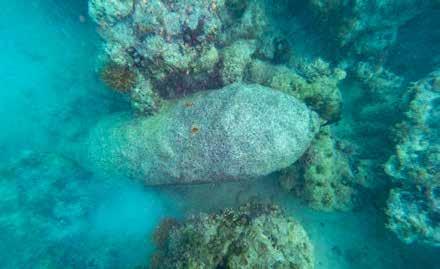

6 | Navy Today #270
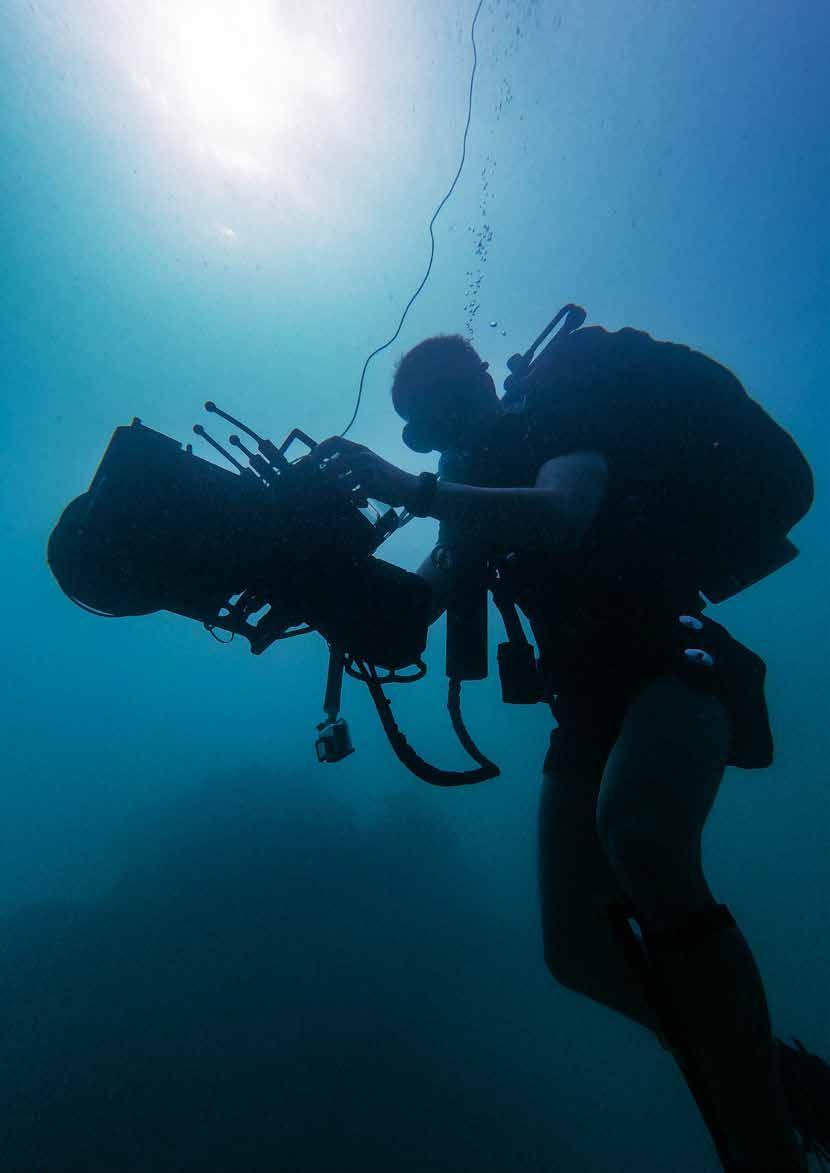
OPERATION RENDER SAFE
Photos: HMNZS MATATAUA Maritime Explosive Ordnance Disposal teams use Diver Underwater Search Systems (DUSS) to locate 500-pound aerial bombs dropped in World War II.
Photos: PO Chris Weissenborn
When it comes to Operation Render Safe, the mapping and disposal of Explosive Remnants of War (ERW) in the Pacific, the Royal New Zealand Navy has often relied on other countries’ vessels. This time, we provided the ride.
The Australian Defence Forceled mission combined the Royal New Zealand Navy, the United States Marine Corps and the Royal Canadian Navy in a week-long survey of Nanumea and Funafuti lagoons, at the request of the Government of Tuvalu.
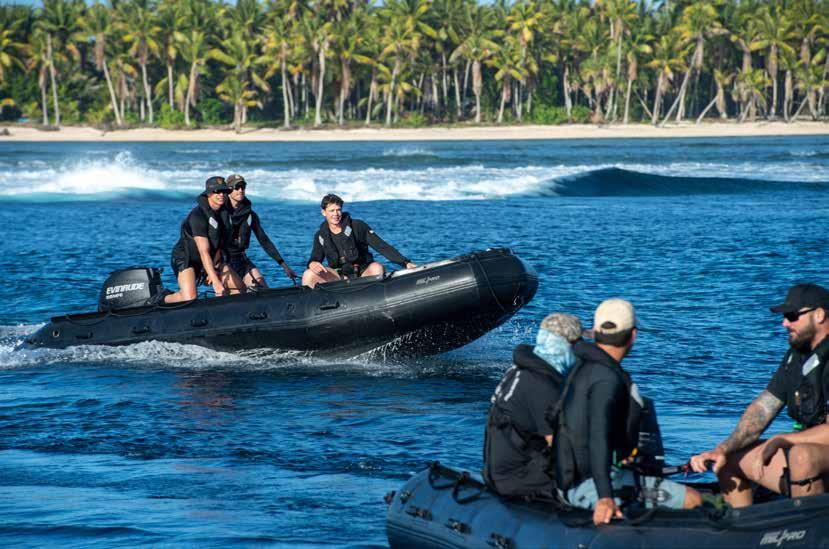
The mission, based off Dive, Hydrographic and Salvage Ship HMNZS MANAWANUI, was to complete a reconnaissance of reported ERW and develop a plan for a future disposal operation.
Arriving in Fiji, MANAWANUI picked up HMNZS MATATAUA Maritime Explosive Ordnance Disposal divers and military hydrographic detachments, and their Royal Australian Navy, Royal Canadian Navy and United States Marine Corps counterparts and proceeded to the sites to start operations.
As it turned out, no unexploded ordnance was located at sites in Funafuti lagoon thought to have remnants, across a five-day search. The release of the area frees up the Government of Tuvalu to proceed with decisions on reclamation operations.
In contrast, just two days in Nanumea lagoon enabled the discovery of 22 500-pound aerial bombs of United States manufacture and four small arms dumps of .50 calibre ammunition placed in ‘dump lines’ in depths of 10 to 18 metres. At the time the approved search area only covered seven per cent of the lagoon, meaning there is still a long way to go to make the lagoon safe.
The RNZN military hydrographic side contributed by using a side scan sonar system and magnetometer in order to help locate objects of interest, which the dive teams were able to explore in further detail.
In all, the teams completed 77 dive serials, totalling 47 hours of dive time. As well as diving to suspected ordnance that had been roughly mapped, the teams conducted 2.62
square kilometres of magnetometer coverage. In all, 3,190kg of ordnance was found in 24 sites, the majority at 15 metres down.
Based on the findings, the Australian Defence Force will send the Government of Tuvalu a full reconnaissance report and recommendations for future removal and disposal.
Lieutenant Commander Teina Hullena, Executive Officer of MANAWANUI – and also a clearance diver by trade – says the mission showcases the many ways the New Zealand Defence Force and partners provide value to the Pacific and help to stabilise environments and promote regional security.
“This operation was the first opportunity for MANAWANUI to operate with an embarked international force over a sustained period. It’s a validation of the ship’s detached diving operations and a real capture of lessons learned.”
8 | Navy Today #270
Operation Render
First Operational Dive
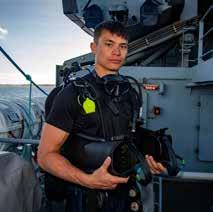
After a quick turnaround, myself and Able Diver Cody Sweet found ourselves right in amongst the action with MATATAUA’s Maritime Explosive Ordnance Disposal Team (MEOD). The operation has proven a huge success for new divers like us, as we experienced our first time involved with Explosive Remnants of War that previously we’d only read about. Working and operating with our senior MATATAUA and HMNZS MANAWANUI personnel has provided the first stepping stone towards both our RNZN Dive and MEOD careers.
To think that one month ago I was diving in waters where I couldn’t see the end of my arm, let alone my buddies, to now being able to surface swim and pick out large targets such as a Catalina bomber or Japanese Zero fighter planes in 30m of water, it is safe to say that Pacific waters are as clear and blue as it gets.
Fortunately for us, our general targets were air-dropped 500lb bombs from WWII. Although their age would suggest a high chance of corrosion or potential for overgrowth and sediment cover they still stuck out like sore thumbs amongst the coral reefs. Where visibility varied, some munitions were harder to spot which is why we developed an innovative technology and a two-diver ‘lawn mower’ search technique utilising the Diver Underwater Search System (DUSS).
The DUSS connects to a GPS float and helps track and record the area accurately, and also has a sonar that can assist the search.
Although the majority of the munitions found were on the sea floor, occasionally you’d come across a tricky situation where the munition was sitting on top of the reef like a Christmas decoration almost three metres off the bottom. Our primary method of marking was via a virtual datum on the DUSS or GPS, but just to make sure the Aussies didn’t claim our targets we also marked them with drop weights.
All of our targets came from intelligence that was almost six years old or even older but as it turned out, most of the coordinates given were bang-on.
Due to the risks involved with operating around and on these munitions we were instructed not to move, jolt or touch any of the ordnance.
Although you’d generally associate tropical waters with colourful corals, reef and game fish as well as the odd reef shark our biggest worry this trip was actually jellyfish. Watching the boys underwater you’d think they were putting their best Nehe MilnerSkudder step on, with the occasional fend as they would slide and shift through the thick walls of jellies. Working with the US Marines and ADF always inspires a little bit of friendly competition, with the outright goal of finding the most Unexploded Ordnance (UXO). Although we are all here for the same reason of rendering safe the waters of Tuvalu, nothing motivates the boys more than one-up’ing the Aussies. Living and working with other nations is always an eye-opener; once you get past the accents and who has the better beers argument you’re away and racing.
I grew up next to the water. Whether it was out fishing with my uncle, diving with my old man, gathering mussels with my grandfather or just a casual swim with family and friends, I would spend any moment I could in and around the sea. Fast forward a few years and now my occupation is to work as a MEOD operator in and around the ocean. To be able to travel overseas to multiple locations, into places unheard of to some just goes to show the opportunities made available in our line of work. It felt great to be able to declare areas safe for the locals to fish and enjoy just like I did as a kid.
If this is the beginning of my career as a RNZN Diver in MATATAUA I cannot wait to see what tomorrow brings!
OPERATION RENDER SAFE Navy Today #270 | 9
safe
is my first operational
deployment
overseas
after graduating
from my Able Diver course
just last month and posting to HMNZS MATATAUA. Able Diver Eduard
Korent
Sun and Stars set Students on course
By SLT Jessica Bewick
The Bridge Warfare Officer Course (BWOC)
is a relatively new course run from the Navigation Training School.
This course is intended to provide Junior Warfare Officers with the tactical knowledge and professional competency required to operate a Major Fleet Unit (or other naval vessel) in benign (Coastal navigation taking charge of Ships in Company) and hostile (Warfare) environments.
BWOC is in its third iteration, and for the astronomical navigation phase this year, the seven students and one Serco instructor joined HMNZS AOTEAROA for her passage from Hawaii to Singapore.

Early mariners relied on observations of the sun and stars to determine their position on the featureless ocean. While modern technology like GPS can now provide an immediate and exceptionally accurate assessment of one’s position, these systems are attractive and likely targets for cyber warfare and spoofing. As such, the Navy continues to teach the traditional methods of astronomical navigation to ensure that ships are able to navigate in GPS-denied environments.
For BWOC 03 the prospect of getting away from the classroom and simulator, and getting out to sea to conduct astro navigation was a welcome change. In previous years the class had conducted this phase on a cruise ship, but there was nothing suitable. So the BWOC students were redirected to meet AOTEAROA in Hawaii following Exercise RIMPAC.
Touching down in the glorious tropical sunshine was a far cry from the chilly winter weather left behind in New Zealand. With five days to wait until sailing, no time in Hawaii was wasted and some serious study was put into the local beaches, food vendors, and stores.
If nothing else, the tan lines gained should be evidence of how much time went into studying the sun prior to using it for navigation.
After sailing from Pearl Harbor, the BWOC students were back into lectures and uniform. Each morning before sunrise and in the evenings after sunset the course would muster on the bridge top and observe the stars, noting their altitude and the exact time of observation. The same was done for the sun mid-morning, midday when the sun reached its highest altitude, and mid-afternoon. This data was plotted to determine the ship’s position, and collectively BWOC provided recommendations of what course and speed to proceed at. This was the routine for nine days as AOTEAROA proceeded west towards the Philippines, before reaching her final destination in Singapore.
AOTEAROA was an ideal ship for the BWOC students to conduct astronavigation on as she is relatively stable, has plenty of space on board for the required equipment and stationery, and provides military context. Other serials the students were exposed to while embarked
10 | Navy Today #270
included Replenishment at Sea, pilotage, aviation, gunnery, Officer Of the Watch Manoeuvres, and incompany time with HMCS WINNIPEG.
And besides the learning opportunities, there were some great highlights, including the ‘Hands to Bathe’ near the Mariana Trench, playing Articulate and badminton, and the evenings spent watching the night sky develop while enjoying music and conversation.
Weeks after joining AOTEAROA in Hawaii, the BWOC students disembarked in Singapore and within 30 hours were back in New Zealand. All BWOC 03 students were assessed as competent in astro navigation, and are now moving on to aviation and warfare training.
From the top: HMNZS AOTEAROA arrives in Singapore.


BWOC 3 students line the bridge top to make observations.
CDR Dave Barr, HMNZS AOTEAROA’s Commanding Officer and LTCDR Chris Tisdall, Navigating Officer, review the students’ calculations.

Navy Today #270 | 11 NAVIGATION TRAINING

12 | Navy Today #270
The Commonwealth farewells the Queen
On 19 September, the New Zealand Defence Force marched in the funeral procession for Her Late Majesty

Queen Elizabeth II in London. Navy Today editor Andrew Bonallack was with the contingent.
It seems improbable that a building complex in Westminster can accommodate 1,600 uniformed personnel, but the Wellington Barracks, home to the British Army’s infantry regiments of the Household Division, effortlessly takes them in. Across the parade ground, two Gurkhas in multi-terrain pattern dress stand ready to open the gates that the troops, when formed up, will march through to take part in their last service to the late Queen.
Tucked away at one end of the parade ground is a large white marquee housing the New Zealand, Australian and Canadian personnel. A group of Australians are playing cards, while many New Zealanders are sitting down, jiggling their legs in anticipation of the long march ahead. Grocery bags of plasters for blisters sit next to bags of sweets, courtesy of a supermarket shop by the contingent’s admin officer. Several soldiers tidy up the rig of a young gunner, who is about to be interviewed by the BBC.
It’s been an intense build-up to this point. Most of the Commonwealth personnel had been flown to the United Kingdom within two days of the Queen’s death, and transported to Pirbright Army Training Centre in Surrey for the week leading up to the funeral. The 24 NZDF personnel, with 64 Canadians and 28 Australians, marched a large circular route between the weathered barracks, becoming familiar with the cadence of 75 steps per minute. British Regimental Sergeant Majors and warrant officers, many armed with
pace sticks, shout commands and move among the contingent when it halts, tapping the ground to shuffle people into position.
In the early hours of 15 September, the contingent buses to London for a night-time full dress rehearsal down the Mall, and the following day, the media assemble at Pirbright as the Prince and Princess of Wales arrive to meet the Commonwealth personnel. The pair chat easily with the sailors, soldiers and aviators. The word ripples among the media that the NZDF personnel, who are last to meet their Royal Highnesses, are going to do the Defence Force haka, and the cameras shuffle to the left, pushing the boundaries of the media pen to try and get a better angle.
FAREWELL TO QUEEN ELIZABETH II
CDR Andy Mahoney, with sword reversed, leads the New Zealand personnel on the left flank of the contingent.
Navy Today #270 | 13
The Prince of Wales nods at the haka’s conclusion and the pair depart, and it is only later that Governor General Cindy Kiro, in a speech at the New Zealand High Commission, passes on to the New Zealanders how impressed the Prince and Princess were with the honour.
On the morning of the 19th, the Commonwealth contingent positions itself in the parade ground of Wellington Barracks. Everyone is in their number one dress, but the Commonwealth, compared to the absolute uniformity of the British regiments and services, present a curiously mixed look. There’s a variety of khakis and greens, berets, slouch hats and lemon squeezers, and the blue and black contrast of Air Force service dress and Navy winter uniforms and white caps.
There are four representatives from each of the four Army regiments, four representatives for Air Force, and four for the Navy: Commander Andy Mahoney, Chief Petty Officer Chef Chris Bowden, Leading Youth Development Specialist Anya Ruri and Able Writer Alberta Moeono-Alaiasa.
AWTR Moeono-Alaiasa is a recent recipient of a Chief of Defence Force commendation and Sailor of the Quarter and thinks that’s why she was chosen to come.
“This is not something to be happy about, but I was really excited to come to this. I’m so honoured to be here,
to experience history in the making. In years to come, my children, my grandchildren could be studying this funeral, and they’ll see me there.”
The Commonwealth contingent is virtually leading the 1,600-strong procession, and it is one of the first away from the Barracks. They march up the Birdcage Walk and turn in front of the gravelled parade ground of Horse Guards, at the extreme end of St James’s Park, pausing there.

“I grew up watching parades in London,” says CDR Mahoney afterwards. He is positioned at the front of the contingent and heading a line of New Zealanders down the left flank. “To be part of one, on this historic day, was an incredibly proud feeling.” The procession could hear the service from Westminster Abbey over the loudspeakers. ‘God Save the King’ is sung, a powerful moment for the paused troops. “And then the two minute-silence, and London went quiet. You could have heard a pin drop. Everyone was captured in that moment.”
With swords drawn, CDR Mahoney and the contingent turn the corner and face down the Mall, lined with flags, guardsmen with bearskin-clad heads bowed, and tens of thousands lining the route.
Further behind the Commonwealth contingent are the Defence Advisers in the United Kingdom, including
Commander Wayne Andrew, Naval Adviser to London. Back even further are the four Colonels Commandant, the ceremonial advisers to each of the NZ Army’s four regiments with Royal links.
The procession circles around the Victoria Memorial, in front of Buckingham Palace, and proceeds the short distance to Wellington Arch, massing at attention on the grass to await the arrival of the Queen’s casket, pulled on a gun carriage by Royal Navy sailors.
For LYDS Ruri, the transfer of the Queen’s casket into the State hearse is her unforgettable moment. She had been trying to look ahead, while standing at attention, but out of the corner of her eye she watched. “It gave me shivers down my spine. We had been standing there for ages, and it was hot, and then it was that moment when I went cold. It was indescribable. We were sore from marching, and standing there, and that made it all worth it.”
The contingent marches back to the barracks and the public, released from the formality, show their appreciation.
“That’s what really hit me,” says Lieutenant Colonel Dean Gerling, Contingent Commander. “The crowd there started clapping and saying thank you. It really tugged at the heart strings and you knew this was worth it.”
Left:The contingent march past Buckingham Palace and the Victoria Memorial during an overnight dress rehearsal.

14 | Navy Today #270
– Lieutenant Colonel Dean Gerling, Contingent Commander.
From top: The Prince of Wales chats to LYDS Anya Ruri (right) and AWTR Alberta Moeono-Alaiasa at Pirbright Army Camp.

The NZDF contingent perform the Defence Force haka for the Prince and Princess of Wales.

FAREWELL TO QUEEN ELIZABETH II
“The crowd there started clapping and saying thank you. It really tugged at the heart strings and you knew this was worth it.”
Navy Today #270 | 15
Commander Prema McIntosh
Teaching Law of War
Navy Today talks to Commander Prema McIntosh, assistant professor of law at the United States Military Academy at West Point, USA.

When it comes to teaching law, CDR McIntosh is on the front line. In front of her daily are engaged US Army cadets, eager to learn how military law works in the real world.
In June, CDR McIntosh started a two-year posting to the United States Military Academy (USMA) at West Point, New York State, teaching Law of War for Commanders to undergraduate cadets.
West Point, she says, is an amazing place to be. “Impressive, beautiful and intimidating! The level of knowledge here is incredible – even lunchtime chats end up broadening my knowledge.”
As an assistant professor in the Law Faculty, CDR McIntosh will teach the course up to the end of semester in December, then teach the same course again in spring up to the summer break. “I also have the opportunity to lecture other courses, and will be covering some parts of the International Law course as well.”
Working with the cadets is incredibly humbling, she says. “The calibre of the cadets is what makes West Point special. They are very smart, very engaged. The process for acceptance is arduous, and includes high grades, athletic and community achievements,
as well as a nomination, including Army personnel, a senator, congressman, the Vice-President or the President. The classes are around 1,000 per year, so the whole USCC (United States Corps of Cadets) is over 4,000.”
In her view, she teaches one of the most important courses at USMA.
“This material will have direct relevance to these cadets when they join the wider US Army as Second Lieutenants – some of them in less than a year. Most will be looking at the combat arms, such as infantry and artillery, which means they immediately put into practice what they learn in the classroom this year. They have great questions and we can get into some good discussions in class about current events and what it means to practise military and operational law in the real world.”
She is also attached to the Lieber Institute for Law and Warfare. “That is USMA’s – and by extension the US Army’s – ‘think tank’ on issues related to the Law of Armed Conflict. In particular it seeks to utilise the military and academic expertise concentrated here at West Point, to examine the role of Law of Armed Conflict in the current conflict climate. I attend and take part in various workshops and conferences, and contribute to the work being
done by the institute. This may include contributing an article to the blog ‘Articles of War’ – which most recently ran a well-received Symposium examining the issues arising out of the Ukraine/Russia conflict.”
In addition, CDR McIntosh will complete an LLM (Master of Laws) by distance learning through the University of Reading.
She acknowledges that she is something of a novelty at USMA.
“I’m fairly sure I’m the only Navy faculty member here, but within the law department there is a Major from the Dutch Air Force, and one from the British Army.”
The cadets call her “ma’am” and salute, but she can tell they are still trying to figure out her uniform. “Timing with salutes is key; you’re trying to walk past thousands of cadets as they transition between classes or are dashing to lunch – it can lead to a fairly tired arm!”
They have plenty of questions for her. “About New Zealand, but also about my experience as a legal officer and what it means to be one. Most of my cadets are law majors, and many have aspirations to later attend law school and join the JAG (Judge Advocate General) Corps.”
16 | Navy Today #270
Are there any big culture differences?
“So, so many. New Zealanders have exposure to US pop culture, but there are so many little things – traditions, routines, and much of it is the scale of everything, from the food, roads and vehicles. And there is so much pride in what they do in the service. We are proud members of the Royal New Zealand Navy, but we don’t have bumper stickers, posters and T-shirts about it. And they should be proud – it is hard and important work that they will do.”
Being Navy has inevitably led to many jokes. “The Army/Navy rivalry is very high, and wherever you look there will be a sign saying ‘Go Army, Beat Navy’. I have been assured a number of times that they don’t mean me, it’s just those ‘US Navy people’ – and mainly the US Naval Academy at Annapolis. The Army/Navy football game is the most anticipated event of the year.”
It sounds intense, but it was surprisingly easy to make the transition to teaching at USMA, she says. She is accommodated on post, so commuting to her office, which has a Hudson River view, is straightforward – something she will be glad of when the snow arrives. Mahan Hall, where she teaches, is directly opposite. She joined with eight other new professors, so there was a solid induction.

In her spare time, she’s been exploring. New York City is an easy two-hour train ride. “I’ve also made the slightly longer trip over to Newport, Rhode Island, where the Naval War College is. I’ve been further north, and explored the beautiful Hudson Valley, and once autumn comes it will be even more so.”
The tempo is slower to her previous role in New Zealand. “It’s good to slow down a little and spend time preparing classes and do the academic work.”
TEACHING LAW AT WEST POINT
“It’s a really good change to think big thoughts and be less reactive. Cadets come to my classes and want to engage in a topic that is interesting and relevant to them, and can be applied to wider events. They will be great assets to the US Army when they graduate.”
Navy Today #270 | 17


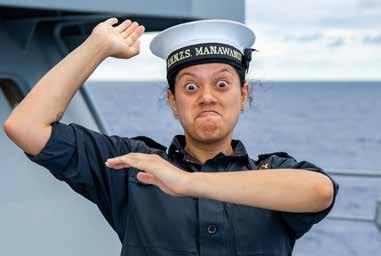
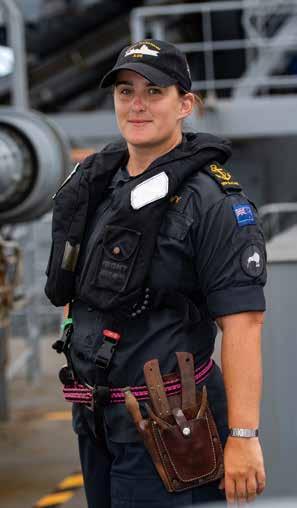



18 | Navy Today #270 4 1 3 6 7 10 8
OUR PEOPLE
1. BCT 22/02 intake engage in teamwork during Shakedown Week at Tamaki Leadership Centre.
2. HMNZS MANAWANUI crew enjoy a hands to bathe during their transit to Tuvalu from Fiji.
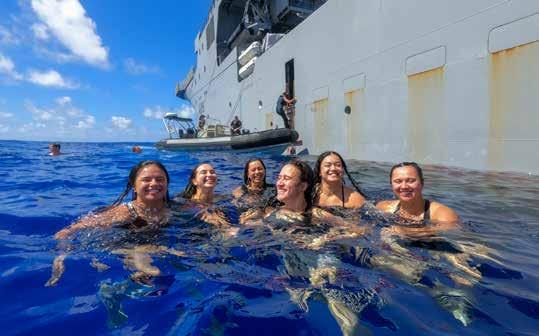
3. Bridge Warfare Officers Course 3 personnel in HMNZS AOTEAROA. From left, SLT Caleb Warren, SLT Alex Titmuss, SLT Caitlin Stone, SLT Jessica Bewick, SLT Zane McEntee, SLT Kieran Meikle and SLT David Trebilco.
4. AET Tash Walsh-Makene celebrates for the camera as HMNZS MANAWANUI heads back to Suva, Fiji, after completing Operation Render Safe.
5. HMNZS MANAWANUI Whole Ship’s Coordinator and Command Senior Rate, CPOSCS Grant Gaffaney.

6. LSCS Victoria Clements, HMNZS MANAWANUI, with her bespoke coxswains toolbelt she made.
7. LT Jacob O’Neill, Navigating Officer HMNZS MANAWANUI.
8. The Chief of Navy, RADM David Proctor (right) chats to Captain Fleet Operational Readiness CAPT Brendon Clark during Devonport Naval Base’s death salute to the late Queen.
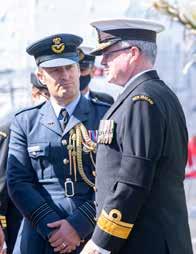
9. CDR Wayne Andrew, Naval Adviser London, marches with his colleagues in the Queen’s Funeral Procession in London.
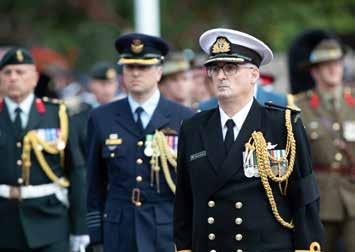
10. AMUS Seluimatai Fotu plays the euphonium. He competed for the first time at the NZ Brass Band Championships.
11. HMNZS MANAWANUI Able Chefs Tamea Te Rauna and Teagan TautalaHanita get a Ship’s barbecue going.

Navy Today #270 | 19
5 2 11 9
Giving back through Youth Development
By Alex Mason, Senior Public Affairs Adviser
LYDS Faleofa
Becoming a dad was the impetus for Leading Youth Development Specialist James Atelea Faleofa to switch trades.

In 2020, LYDS Faleofa felt he’d reached a point in his career where it was time to give back to the community.
He’d served as a Chef since joining the Royal New Zealand Navy in 2009.
“As a new father and experiencing what I have in my 10 years in the Navy, I wanted to ensure the next generation had an opportunity to step out of their comfort zone, and a chance to explore, experience and appreciate life,” LYDS Faleofa says.
So he joined the tri-service Youth Development Unit.
Together, YDU and Cadet Forces deliver courses to more than 6,000 young people every year.
They include the six-week Limited Service Volunteer (LSV) course, for unemployed 18-to-24 year olds who are not in study or training.
In the field and the classroom, Youth Development Specialists help motivate trainees and boost their self-confidence; teaching teamwork, resilience, and life skills.
LYDS Faleofa says from the moment the trainees walk through the gates, he’s determined to do all he can to ensure they leave with a new perspective on life.
“You learn that the majority of them just needed a chance. Over the six-week period young leaders start to show, others begin to learn more about themselves, and others find a spark within them – to not only make a change, but be the change.”
He says it can be very challenging mentally and not everyone completes the LSV course.
“The feeling I get when I see the trainees march out on graduation day is priceless. I see their family and friends expressing their joy, and the trainees beaming with pride.
“I know that I have done my part in guiding them in a direction I hope they continue.”
YDU also supports 29 Services Academies within secondary schools, fostering skills and values to help senior students take positive roles in society.
LYDS Faleofa was once in their shoes; as part of the Kelston Boys’ Services Academy he was inspired to join the Navy by Warrant Officer Seaman Combat Specialist Ngahiwi Walker’s stories of life at sea.
Now he’s giving back, through an organisation called Fahi On; a group of former and current Kelston Boys’ High School students striving to be the best they can be.

20 | Navy Today #270
“YDU has given me the tools to work with the youth in my area, to allow them to get the best opportunity in life.”
20 | Navy Today #270
HMNZS TAUPO ASSISTS NELSON AFTER FLOOD
It’s the role of Inshore Patrol Vessel HMNZS TAUPO to call into ports around New Zealand as part of its ongoing Officer of the Watch training. But when flooding struck Nelson a few days out from their arrival, the ship asked what it could do to help.
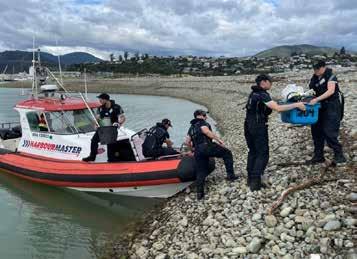
The flooding and subsequent state of emergency between 17 and 22 August meant large amounts of debris was drifting in Nelson Harbour, causing a hazard to shipping.
TAUPO offered assistance through liaison with Nelson’s Regional Naval Officer and the Port/Harbour Master. When they arrived on a Friday, Commanding Officer Lieutenant Fletcher Slierendrecht said it was pretty evident there were problems. “When we entered harbour we were dodging logs and the water was still a muddy brown.”
The ship berthed as scheduled, then 11 personnel got to work.
A seaboat with eight personnel headed to the Boulder Bank to move debris and collect rubbish. The seaboat also towed logs from the harbour to the shoreline for later removal. A sailor embarked on board the Harbour Master’s boat, helping with similar rubbish clean-up and logtowing near Haulashore Island.
In the space of three hours the sailors cleared around 50kg of rubbish and numerous large logs and trees from the harbours, something that would have taken the Harbour Master a week.
“It was great to see so many volunteers keen to get involved and the Nelson Port/Harbour Master were very appreciative of the offer of assistance. The team enjoyed helping out and were more than happy to volunteer.”

FACES OF YOUR FORCE Navy Today #270 | 21
India and New Zealand Navies sign pact
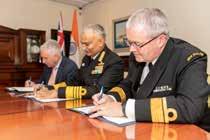
The Royal New Zealand Navy together with the National Maritime Coordination Centre, has signed an Arrangement on White Shipping Information Exchange with the Indian Navy, during a visit by the Indian Chief of Naval Staff, Admiral R Hari Kumar to Auckland late last month.

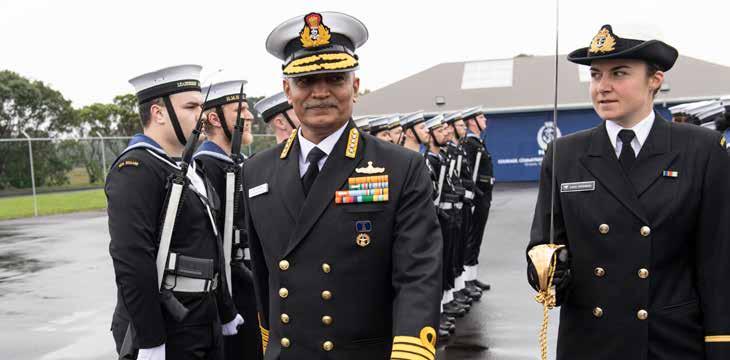
In a media release, the Indian Ministry of Defence described it as a ‘milestone development’. The agreement enables the exchange of information on the identity and movement of commercial vessels of interest. White Shipping is a term which traditionally refers to the merchant fleet (as opposed to the naval, or grey fleet). The agreement will enhance maritime domain awareness and help with the identification of illegal shipping and threats to sea routes.
ADM Kumar was welcomed with a pōwhiri at Te Taua Moana Marae and received a guard of honour on North Yard parade ground. His arrival coincided with the 81st birthday celebrations, which included a Beat Retreat and Sunset ceremony, and he also received a tour of the National Museum of the Royal New Zealand Navy. Both Navy leaders are looking to expand the scale and scope of bilateral activities in the coming years.
Illegal vessels are often referred to as ‘dark shipping’ due to their practice of ‘going dark’ by switching off their Automatic Identification System transponders.
22 | Navy Today #270
Maritime Culture Survey
The Maritime Culture Guardianship Group

has completed its first phase of the Navy’s Culture initiative, based in part on a substantial response to the Maritime Culture Survey across February and March of this year.
The Maritime Culture Guardianship Group (MCGG) was formed out of a restorative justice session that came from an experience of inappropriate and harmful behaviour. During this session, it was identified there were a number of systemic issues that underpinned those experiences and that it was important to address these issues to ensure positive change. The creation of the MCGG coincided with results from the 2021 annual engagement survey indicating increased levels of dissatisfaction, and the sense that the extended COVID lockdown in Auckland and ongoing support to Operation Protect were impacting on our people.
In late 2021 the MCGG established a culture-focused initiative to understand where the strengths and gaps were in our culture – i.e. how things were done around here. The establishment and prioritisation of the initiative was
communicated out to the wider Navy in a ‘Chief of Navy, With All Despatch’. The initiative has four key phases: Understanding the culture in the Navy; Analysis of the information found and where we want to be; Prioritisation on the areas we as a Navy want to focus on to shift our behaviours and experience; and Action to pursue identified priorities.
The culture survey results, based on 1,143 responses, forms a key part of our understanding of the culture we have. The results suggested that we are at our best when we come together in teams to solve challenging problems and deliver results under the direction of good leaders. Team work/ mahi tahi is at the heart of what we do. The survey results also suggested that there are gaps in how we share information up and down the chain of command and that there is room for improvement in this area. Improving our internal communications will likely have a significant impact on a number of other areas in the system, including building trust in our leadership and ensuring everyone clearly understands our unique mission and purpose.
Following the survey, focus groups were held with junior rates and junior officers to ensure their views were represented – particularly in building the future culture of our Navy. Information from the recent Pulse survey, employee exit surveys, career management reviews and a review of some of our key communication and other artefacts were also utilised to help create the Understand report, which will be presented to the Naval Leadership Board this month and reported on in future Navy Today articles.
“The Understand phase has highlighted key areas that will drive initiatives and activities to grow our culture,” says
Captain Brendon Oakley, who is leading the MCGG alongside Captain Simon Griffiths. “We needed to be able to truly understand and measure our culture, to aid and guide our culture growth, and the survey was a large piece of gaining this clarity.”
“We’re at a pivotal time, just coming out of COVID, and we have many, many positive things occurring. We understand what our strengths are. We understand how our people view our organisation and the way we do things. And importantly we understand the key areas to work on, and the areas where we can improve.”
Alongside the Understand report, the MCGG is using the data gathered in delivering Maritime Culture Foundation workshops for a range of Navy leaders and partners, to learn to build effective, high-performing cultures across the organisation. Three workshops have been delivered to date, with another two planned.
Navy Today #270 | 23
“The workshops are helping us understand the culture we want to have, where we want to grow, and how we can positively impact the culture of our organisation.”
BUSY BANDIES
By AMUS Elijah Taula
For the Royal New Zealand Navy Band, the past 18 months have been a whirlwind of uncertainty and curve-balls for us all; many of us have found that due to unprecedented circumstances, the pursuit of our passions and ambitions has become increasingly difficult.

For the RNZN Band, this has meant a significant drop in output capabilities and opportunities to perform. However, this has not stopped our personnel from working on our craft and preparing for performance opportunities to arise again. Public engagement has been scarce, but this has not prevented us from staying ‘game ready’.
During COVID-19, the band was heavily utilised for both OP PROTECT and OP HIGHROAD, manning the Managed Isolation and Quarantine Facilities (MIQF) and the borders either side of Auckland. We were also involved in assisting the Base in duties during the initial lockdowns,
including security at the gates. Chief Petty Officer Musician Philip Spriggs was frequently utilised in the MIQF Manager role. “It was good to do something different for a change, and I was definitely grateful to be working during such a difficult time,” said CPOMUS Spriggs. “It also gave the band an opportunity to network with the wider fleet and people who we wouldn’t often cross paths with in our day-to-day. While it was difficult being isolated from loved ones during this time, the experience gained has been valuable and we are proud to have contributed.”
In July, six of our band members took part in the annual New Zealand
Brass Band National Championships. Petty Officer Musician Colin Clark and Able Musician Natalie Williams were both instrumental parts of their respective ensembles. POMUS Clark – a virtuosic soprano cornet player – and North Shore Brass were awarded second place in the A Grade Competition, and AMUS Williams – a talented tenor horn player – walked away with a first place award in B Grade with Auckland City Brass.
Finally, CPOMUS Spriggs and Petty Officer Musician Fraser Robertson attended festivities as our recruitment contingent, also playing for Te Awamutu Brass – POMUS Robertson’s hometown
24 | Navy Today #270
band. CPOMUS Spriggs was also awarded first place in the variation solo section on bass trombone. We are incredibly proud of our bandies’ successes in other formal ensembles, and believe these experiences outside of work help us to develop as musicians and professionals.
A number of our team also belong to contemporary groups outside of Navy duties. In August our newest band member – Leading Musician Te Aranga Savage – won numerous accolades at the Pacific Music Awards as the lead vocalist of NZ reggae/roots band Tomorrow People. Another bandy thriving in the reggae/ roots arena is Able Musician Daniel Reshtan, one of New Zealand’s premier tenor saxophonists. He often plays for the likes of Stan Walker, Katchafire, and Three Houses Down. Able Musician Alden Cai has received recognition in the Auckland Philharmonic Orchestra as one of the country’s top French horn players. Finally, Able Musician Jesse Wood
– the RNZN Band’s ‘Swiss Army knife’ – has shared his talents in shows such as ‘Drag Orchestrated’ and ‘I’m Still Standing: The Elton John Experience’ as both a pianist and saxophonist. Their experience and industry knowledge are something the Band is extremely privileged to have, and we applaud them on their successes both inside and outside the Navy.
The gigs have started to roll in more frequently over the second half of 2022.

On 12 August our RNZN Pasifika Performance Group had the privilege of performing at the pre-match of the NZ Warriors versus Canterbury Bulldogs NRL match. This was a significant highlight for us, as it was our first performance at a large scale public engagement, as well as the first Pasifika group performance in a long while. We have also been involved in HMNZS NGAPONA functions at the Museum, Officers Mess Events at Whenuapai, and HMNZS TE MANA’s homecoming.
What awaits us next year?
The band has already begun preparations for a busy opening half of 2023, with Waitangi festivities and the Napier Art Deco Festival taking place in February. We also look forward to returning to Anzac Day ceremonial participation and a number of domestic tours. The wait has been long, but it seems that in a short time the RNZN Band will be back on the road. Keep an eye out for upcoming concerts and feel free to reach out to us with any performance requests; we are after all, your band.

Clockwise from left: CPOMUS Philip Spriggs on trombone.
From left, POMUS Colin Clark, CPOMUS Philip Spriggs, POMUS Fraser Robertson, AMUS Seluimatai Fotu and AMUS Natalie Williams.
From left, Able Musicians Jesse Wood, Daniel Reshtan and Alden Cai.

NAVY BAND ACTIVITIES Navy Today #270 | 25
Navy Today meets Dr Nikhilesh Todkari, a GP who was inspired to join the Navy and undertake the new Naval Reserve Common Training course.

IS THERE A DOCTOR IN THE HOUSE?
Four years ago, Dr Nikhilesh Todkari was taking a lunch break from a GP’s medical conference in Auckland. There was the usual range of stalls outside the venue, for pharmaceuticals and medical equipment, but it was a large Defence Force banner that brought him to a halt.
“We’re looking for doctors,” said the soldier at the Defence Force recruitment stand, and started into his pitch. Dr Todkari stopped him. He was not born in New Zealand, but was a Permanent Resident. He also wondered if he was over the age bracket to start a Navy career. The soldier said, “No, you’re not, you’re fine.”
With great enthusiasm, Dr Todkari put an application in that same evening. “As a doctor I spend time in a clinic –that’s what I know. I asked him about deployments and he told me we need doctors to go to places like the Pacific Islands. It was the uniqueness and diversity of this role that captured my interest, along with the privilege of serving the country.”
Dr Todkari is a man who knows how to give value and juggles multiple roles. He works as a GP at Ropata Medical Centre in Lower Hutt, is a Skin Cancer Specialist at the Vein and Skin Clinic, and provides remote consultation for rest home care in Taranaki. “It’s very hard to get doctors in the regions to cover rest homes. I do weekly checkins with the nurse, speak to rest home residents and their families via Zoom. Once a month I fly up there to conduct ward rounds and provide availability in person.” In addition to this, Dr. Todkari is also on a roster for the NZ Police across the Wellington region, providing medical assistance.
Dr Todkari put in his application to join the Regular Force, and was eyeing up the Navy because his wife was looking at a job in Auckland. However, she secured a great job in Wellington which required a change to their initial plan. “Someone suggested the Naval Reserves. I could still be based in Wellington, without having to leave my job or relocate the family, but I could attend the Reserve unit every week and fly up to Devonport for duties. That sounded perfect!”
26 | Navy Today #270
Today, Midshipman Todkari is part-way through the Naval Reserve Common Training course for 2022/2023, a new course designed to ensure reservists are trained to the same standard as their Regular Force counterparts, but in a way that works around their civilian employment.
Starting in January 2022, MID Todkari is among 16 officers and 8 ratings, joining them for 10-day residential blocks at Devonport Naval Base. He attends weekly training at HMNZS OLPHERT in Lower Hutt, undergoes remote learning and undertakes some weekend training. He will graduate in April 2023.

“It’s quite a wide range of people on the course, and that’s been a real highlight,” he says. “In medicine, you work within the same circle of professionals, but here, there’s a lot of experience from all walks of life and varied professions, which has been an excellent opportunity to learn from others as well.”
The course is ab initio – from the beginning – training, with residential phases covering drill, early morning activities, PT, daily Colours and Sunset ceremonies, amid a packed schedule of deliberately tight timings, late nights and plenty of cleaning and ironing. Throughout the year, the recruits cover subjects including the military justice system, the Law of Armed Conflict, sexual ethics, resilience and Lead Self.
He has found the training a steep learning curve. “I don’t know of any other doctor going out in the weekend to train to shoot, for example. There are some on the course who have commissioned from the ranks, and they’re used to it, whereas I’ve probably got the least amount of Defence Force experience. It’s like going back to school again. The language is different, traditions are different, customs are different. I have to work twice as hard to keep up, and that’s been my biggest challenge. Yet the experience has been exhilarating.”
The instructors are professional, outcome-driven but also very patient, he says. “They explain everything. But the onus is on you to do the hard yards.”
He says the good thing about the role is that it is tri-service. “I’m not just tied to Navy deployments. There could be an Army or Air Force deployment that I could be sent on as well. Once I finish, my Divisional Officer will provide me with their directions and recommendations. The great thing about being in the Reserve Force is that it allows me to keep my home base and the job I have. I can go on deployment, complete a task, return home. This definitely suits me and my family needs.”
MID Todkari says he would like to be that person in uniform at a recruiting stand at a medical conference one day and would like to inspire other healthcare professionals to join the Defence Force.
Navy Today #270 | 27
Lieutenant Rae Tailby
PREPARED TO DEPLOY
LT Tailby, an Adult Education specialist from Kaeo and Kaitaia, joined the Navy at age 45, graduating in July 2020. As a LDO, her role is to provide specialist training and guidance on learning to NZDF commanders and units across New Zealand, creating training courses, developing instructional standards and providing personal development advice. But when those units happen to be ships, sometimes it’s better to be developing training on the ship rather than from an office – especially if that ship is on the move.

She had already taken a professional look at the training systems in HMNZS AOTEAROA, and recommended that an LDO be sent on the ship when it next deployed. LT Tailby also became a member of the Maritime Test and Evaluation Authority team, responsible for ‘Personnel and Training’ observations during the test and evaluation stages on new ships as part of their journey towards Operational Release.
“A week later, before AOTEAROA sailed, I was told, you’re going. I thought, wow. I had never been to sea. And that’s how it started.”
HMNZS AOTEAROA in Antarctica in February.

28 | Navy Today #270
A commissioned officer, no matter what role, has to be prepared to deploy. It’s a truism Learning Development Officer (LDO) Lieutenant Rae Tailby has emphatically demonstrated.
Based in AOTEAROA, LT Tailby has been on last year’s South East Asia deployment, including Exercise Bersama Gold in Singapore, with a stopover in Guam. She went with AOTEAROA to Tonga following the volcanic eruption and tsunami in January, and then – because no-one could embark or disembark due to COVID protocols – she was then able to carry on for the ship’s Antarctic resupply mission to Scott and McMurdo bases.
Rolling up her sleeves, she has the proof – a small tattoo of a turtle for crossing the Equator, and another tattoo of a penguin on the other arm for crossing the Antarctic Circle.
“I didn’t get one for Hawaii – Hawaii was beautiful, and having the experience of spending a night on an American ship USNS WASHINGTON CHAMBERS was great. But the boat transfer and having to climb up a flimsy pilot ladder on a ship way bigger than AOTEAROA is something I don’t need a lifetime memory of.”
She hasn’t gone rogue as an LDO, she says. “But you get to hear all these salty sailors boasting about being at sea, and as an LDO, you don’t usually get to go, so the opportunity to do some deployments has been invaluable as an LDO, as it is incredibly beneficial to be able to make recommendations when you can contextualise real life at sea –as opposed to reading about it or listening to others talk about it.”
Being on a ship means she got to see the training delivered. “When we got AOTEAROA, we were in the middle of COVID. Normally industries would send out trainers, but that couldn’t

happen, so we got training manuals – 700 files with training information. It’s the LDO’s job to look at these training systems and validate the recommended training. We had to figure out what was needed, and how long training should be for. So for me, it’s about having professional curiosity, and asking questions. How is this done? How is this recorded? It’s about how we, as an organisation, protect ourselves better and ensure our people are confident and competent. Commanding Officers and Executive Officers have to have faith the training systems in place are working.”
Ashore, she has the same responsibility for training systems. “That’s where I would like to see myself going, continually working between the schools and the ships, to ensure it’s all current.”
She is very attached to her ‘first’ ship, AOTEAROA, but she’s spent a week in HMNZS MANAWANUI, looking at Remotely Operated Vehicle (ROV) training, and next year expects to be working with the frigates, looking at the training related to the Frigate Systems Upgrades.
Her husband is a former hydrographic officer and their son Dylan, who joined the Navy before her, has changed trade from Supply Officer to LDO.
“People getting the right training puts me in my happy space,” she says.
“I love the job, and I’m not about sitting around. I’m wearing a uniform, and I’m about wanting to get out there and be nosy and learn Navy stuff.”
PROFILE Navy Today #270 | 29
LT Rae Tailby pictured at Scott Base.
Far from limping along
Jack Donnelly BEM interviews Korean War veteran Te Uranga O Te Ra Tuwhakairiora ‘Toti’ Tuhaka. QSM, Ngāti Porou, at the Gisborne RSA.
One might wonder how someone christened at the Porourangi Marae in 1935 by Sir Āpirana Ngata, with the names Te Uranga O Te Ra (arrival of the sun) Tuwhakairiora (a Ngāti Porou ancestor), could end up with the nickname of Toti or Totitoi, meaning to ‘limp along’. The story is that as a young boy, Toti was given the job of caring for his grandfather Turei, who walked with a permanent limp after a fall from his horse. Every day they could be seen limping together, and so the name Toti stuck to this day.
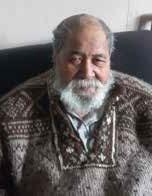
One day during his first year at Ruatoria High School the Navy recruiters arrived. “Who are they?” Toti said to a mate. “What are they talking about?” The boys had never ever seen a Navy warship. His mate said, “Let’s join that Navy”.
Nine of the students went through to Gisborne on the back of a cream truck, squeezed among the cream cans. The recruiting office was part of the Gisborne RSA in those days. Toti and his mates sat the entrance exam but only Toti passed, and a
few weeks later he received a letter saying he had been accepted to join the RNZN. His bus trip to Auckland was a real “eye opener”, he says.
As a 15-year-old boy seaman, nine months on Motuihe Island, known as ‘the Rock’, was a harsh reality, but Toti enjoyed the tough discipline and camaraderie that the training brought to his life. He then drafted to cruiser HMNZS BELLONA for sea training and to categorise the boys into specialist qualifications. Toti had no preference; he was selected to be a gunnery rate. When the Korean War broke out in June 1950 he was drafted to Lochclass frigate HMNZS HAWEA for a 12-month deployment.
Toti was a gunner loading the ship’s main armament, its four-inch gun.
“I never worried too much about my

30 | Navy Today #270
KOREAN WAR VETERAN
HMNZS HAWEA
HMNZS HAWEA patrols the Han River, Korea.
RNZN
safety whenever we went into action, my sole aim was to keep the gun firing.”
He never knew whether they hit their targets, or the identity of the targets they fired on.
Their main mission was to patrol the Han River, offer Naval Gun Fire Support (NGFS) and to engage opportune shore targets when the occasion arose. He remembers the ship going up the Han River to shore-spot for the American battleship USS MISSOURI.

They came under heavy fire from a shore battery, with shells falling all around them, sometimes only a few yards away. HAWEA withdrew at full speed, zig-zagging from the area. Toti and his gun crew were helpless to do anything as their gun could not train beyond the safety arcs. “It was a horrific feeling that I felt, as we were so vulnerable for that period of time.” How their ship never got hit was a miracle, Toti says. “God must have been on our side that day.”
Back home on leave, Toti was cutting scrub on the hills when a local policeman found him. “Hey, Toti, you’ve been recalled back to the Naval Base immediately.” He was drafted to another Loch-class frigate, HMNZS KANIERE, to go back to Korea.
He remembers the freezing cold subzero weather conditions. Whenever they went onto the upper deck they had to keep the snow from forming on certain parts of their weapons. “As a more experienced gunner I was also required to take charge of the 40/60 Bofor close-range gun and teach the crew gun drill.”
KANIERE was on patrol and engaged against shore targets when the cease fire was declared. The ship continued on in a peacekeeping role until she returned home in March 1954.
You never get used to war, says Toti. “It’s something that remains with you forever. I am just so proud that I served and so grateful that I lived.”
When he left the Navy in 1958, he worked for the Gisborne Harbour Board as a diver (he had also been a ship’s diver in the Navy), then worked for the railway as an electrician specialising in tunnel lighting. A former shipmate, Brian “Brushes” Nolan asked Toti to join him in a diving job on Dutch dredge Formosa Prince which had come to Gisborne to dredge parts of the harbour. He took that on, but declined to go to Singapore with the dredge – his wife Teaaupare (Bena) was pregnant.
He has taught at both Gisborne Girls’ and Boys’ High Schools, Lytton High School, Waikirikiri School, Campion College and Wellington Girls’ College.
He’s helped trade school apprentices gain employment and as a member of Gisborne RSA has assisted exservicemen with their war pensions and allowances. He received the Queen’s Service Medal in the 2016 New Year’s Honours List.
Today, Toti enjoys going to the RSA with his daughter and carer Simone, where he has a beer, a meal, and a talk about his adventures. At home he is surrounded by his mokos who take loving care of their “Pop”, a Navy veteran whose life has been a long and wonderful voyage.

Navy Today #270 | 31 OUR HISTORY KOREAN WAR VETERAN
Photo:
Museum / AAP0046
HISTORY: SNAPSHOT
THE BOSUN’S CHAIR
The Bosun’s Chair was a means of suspending a sailor over the side, or aloft, to carry out maintenance, usually painting or chipping rust spots on the hull. This cartoon by Lawrence “Inky” McNicol, from the sixties, is courtesy of the Ex-Royal Naval Mens’ Association of NZ (Napier Branch), while the photo shows sailors touching up the stern of frigate HMNZS OTAGO in 1961 (National Museum of the Royal New Zealand Navy).

Navy Today is not sure when the practice ceased, but consensus appears to be that Working at Height navy regulations in 2004 and the phasing out of the Leander-class frigates (HMNZS CANTERBURY was the last to decommission in 2005) ended the practice. Conversation on Navy social media suggests the bosun’s chair was part of daily life in CANTERBURY in 2000 and still in use by 2005, albeit with workers using fall-arrest harnesses.
Today, hull painting is carried out by dockyard contractors during maintenance periods.
(Photo: SN 61 01496 01 Museum of the Royal New Zealand Navy)

32 | Navy Today #270
IN THE THICK OF IT

The annual Junior Officer Inter-Service Sports Tournament (JOIST) is a sports tournament contested between the three Services’ initial officer training courses to generate esprit de corps, build relationships, and compete in good-natured inter-Service rivalry.
Last month, over a week, the three Services carried out Lead Teams lessons, introduction to each Service, and competed for the JOIST Trophy and Weka Cup. Competitions included Touch Rugby and Kia-o-Rahi (a traditional Māori ball sport) for the JOIST Trophy, orienteering for the JOIST Trophy, and the Endurance Challenge for the Weka Cup. The last was a mud run at Ngataringa Bay, with everyone washing off at the finish line at Stanley Bay. Congratulations to NZ Army for winning both the Trophy and the Cup.

Navy Today #270 | 33
Human Intelligence in the New Zealand Defence Force

In the last 20 years, the Kiwi attitude and psyche on operations has proven to be a winning combination when working amongst a local population. NZDF has established a reputation for effective engagement in all environments from the Pacific to the Middle East, conducting activities ranging from patrol questioning, and liaison, to intelligence collection.
WHAT IS HUMINT?
HUMINT encompasses capabilities which leverage human sources and individuals of intelligence interest to support NZDF operations. HUMINT provides a unique perspective on the human terrain and the motivations and intentions of an adversary.
WHERE DOES HUMINT FIT WITHIN NZDF?
Within the NZDF context, HUMINT is conducted by both specialist and non-specialist HUMINT entities with utility at tactical, operational and strategic levels across all Services. As the capability grows, units throughout Defence are employing qualified personnel to capture information of intelligence value. The NZDF also has a specialist HUMINT Source Operations unit in 1 NZ BDE.
HUMINT TRAINING
The School of Military Intelligence and Security (SMIS), Mission Command Training Centre (MCTC), is responsible for delivering all individual HUMINT training for the NZDF.
WHAT TRAINING OPPORTUNITIES DOES SMIS OFFER?
Debriefing: Debriefing is the formal and systematic questioning of selected, willing individuals by specifically trained personnel in order to gather information of relevance. MCTC regularly delivers the fiveday Tri-Service Debriefing Course, which qualifies students to conduct debriefing operations. This base level HUMINT training is an ‘any trade’ skill and does not require any previous experience as students receive theory and practical exercises, including the employment of linguists.
Tactical Questioning: Tactical questioning (TQ) is obtaining information from Captured Persons (CPERS). TQ is neither debriefing nor interrogation, but is the first phase of questioning, conducted on willing CPERS as soon as possible after capture and normally at unit level. MCTC has developed the Material and Personnel Exploitation Course, which includes a TQ component. This training is an ‘any trade’ skill and does not require any previous experience.
Defence Source Operations Series: The Defence Source Operations Series are the NZDF’s specialist HUMINT trade courses. MCTC offers a training pathway for suitable personnel of all trades with no previous experience.
Defence Source Operations Assessment (DSOA): The DSOA is a four-day assessment designed to identify personnel from across the NZDF who are suitable for specialist HUMINT training. HUMINT operators will interact with a wide range of individuals from an array of different backgrounds, cultures, religions and values; the ideal HUMINT team should reflect this diversity and as such, NZDF service personnel of all ages, ethnicities, genders and trades are encouraged to apply.
34 | Navy Today #270
34 | Navy Today #270
04
Job title and description: Commanding Officer Leadership Development Group.
Date joined: Ahemmmm – 12 March 1986 (cough, cough)!
First ship posted to: HMNZS TUI (after a very short stint on HMNZS MONOWAI).
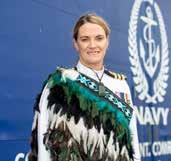
Best deployment(s): Kosovo with KIWI KOSAID in 1999. This was a bespoke medical deployment that was sent by the Government in response to the displaced refugees who arrived in Macedonia. The medical team of seven was based in a refugee camp outside of Macedonia; the camp grew from 14,000 to over 30,000 in just five days. It was a harrowing, yet rewarding experience; one where we were exposed to the traumas of war and injustices bestowed on people who were powerless as a consequence of war. It was the genesis of my passion for philanthropy – my desire to do good for people where ever I can.
Hometown: Oamaru.
High school: St Kevin’s College, Oamaru.
07
Favourite book: This is hard, I love reading! Birdsong by Sebastian Faulks. But, another good read is The Seven Sisters by Lucinda Riley –based on the star constellation Pleiades (which is the same star constellation we celebrate for Matariki).
09
Favourite movie: Grease! RIP Olivia Newton-John.
Favourite album: Does anyone listen to Albums? Spotify playlists are my go-to. I create them with my kids/friends for road trips and it becomes a memory of moments in time! Fav genre of music is Reggae. PS: I might still secretly have my Eric Clapton ‘Cream’ album stashed ready for the great comeback of the turntable!
Favourite song: Anything by Bob Marley.
Favourite holiday destination: Opape – on the East Coast of the North Island.
Favourite things outside of work: Doing things with my friends and kids.
One thing people don’t know about me: I met Nelson Mandela.
A person that taught me a valuable life lesson is: Life itself! And that life lesson is, no-one is responsible for your happiness, but you! Your attitude, your demeanour and mindset in good times and bad will impact on the quality of the life you choose to lead. How you overcome setbacks is a choice and is the key to how you celebrate your successes.
15
How would you describe the Navy in 10 words or less: Our Navy is a Navy that consistently strives to be progressive, despite the challenges of today and tomorrow.
15 ROUNDS 01 06 02 12 03 14 05 WITH COMMANDER KERRY TUTTY 15 ROUNDS
08
11 10
13
Navy Today #270 | 35
